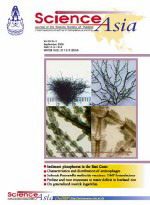ThaiScience
ThaiScience
SCIENCE ASIA
Volume 46, No. 03, Month JUNE, Year 2020, Pages 280 - 287
Novel ssr and snp markers in viola yedoensis makino resistant to cadmium stress
Hua Peng, Jian Gao, Chun Zhang, Lilan Ou, Mao Luo
Abstract Download PDF
Viola yedoensis Makino is a well-known native Chinese medicinal plant, which is reported to adapt to heavy metal pollution regions. In our preliminary studies, transcriptome sequencing was employed to identify global expression gene using a combined bioinformatics, and plenty of differential expression genes (DEGs) were also identified in V. yedoensis Makino responsive to cadmium (Cd) pollution. However, the relative molecular marker development was not expounded. In this study, we aimed to identify novel SSR (simple sequence repeat) and SNP (single-nucleotide polymorphism) markers in V. yedoensis Makino, as well as further study of the functional annotation, classification, and phylogenetic analysis of cyclotide family genes. Approximate 91.99 million high-quality clean reads were generated. 11176 simple sequence repeats (SSRs) were predicted in 9644 unigenes, of which, 1283 unigenes contained multiple SSRs. The SSRs consisted of 1732 dinucleotide motifs, 2733 trinucleotide motifs, 135 tetranucleotide motifs, 17 pentanucleotide motifs, and 13 hexanucleotide motifs. 163 motifs were detected among all of the SSRs identified. Moreover, 8250 SNP markers were detected in 1934 unigenes and 11328 SNP markers were detected in 2510 unigenes in VIYCd and VIYCK library respectively. Furthermore, 41 cyclotide family Unigenes in Violaceae were identified and categorized into six groups with the other species. This study firstly generated a valuable resource for SNP and SSR marker development studies of Violaceae transcriptome and thereby providing the basis for further studies on genomics and functional genomics in Violaceae.
Keywords
Viola yedoensis Makino, SSRs, SNPs, cyclotide familySCIENCE ASIA
Published by : The Science Society of Thailand
Contributions welcome at : http://www.scienceasia.org/
